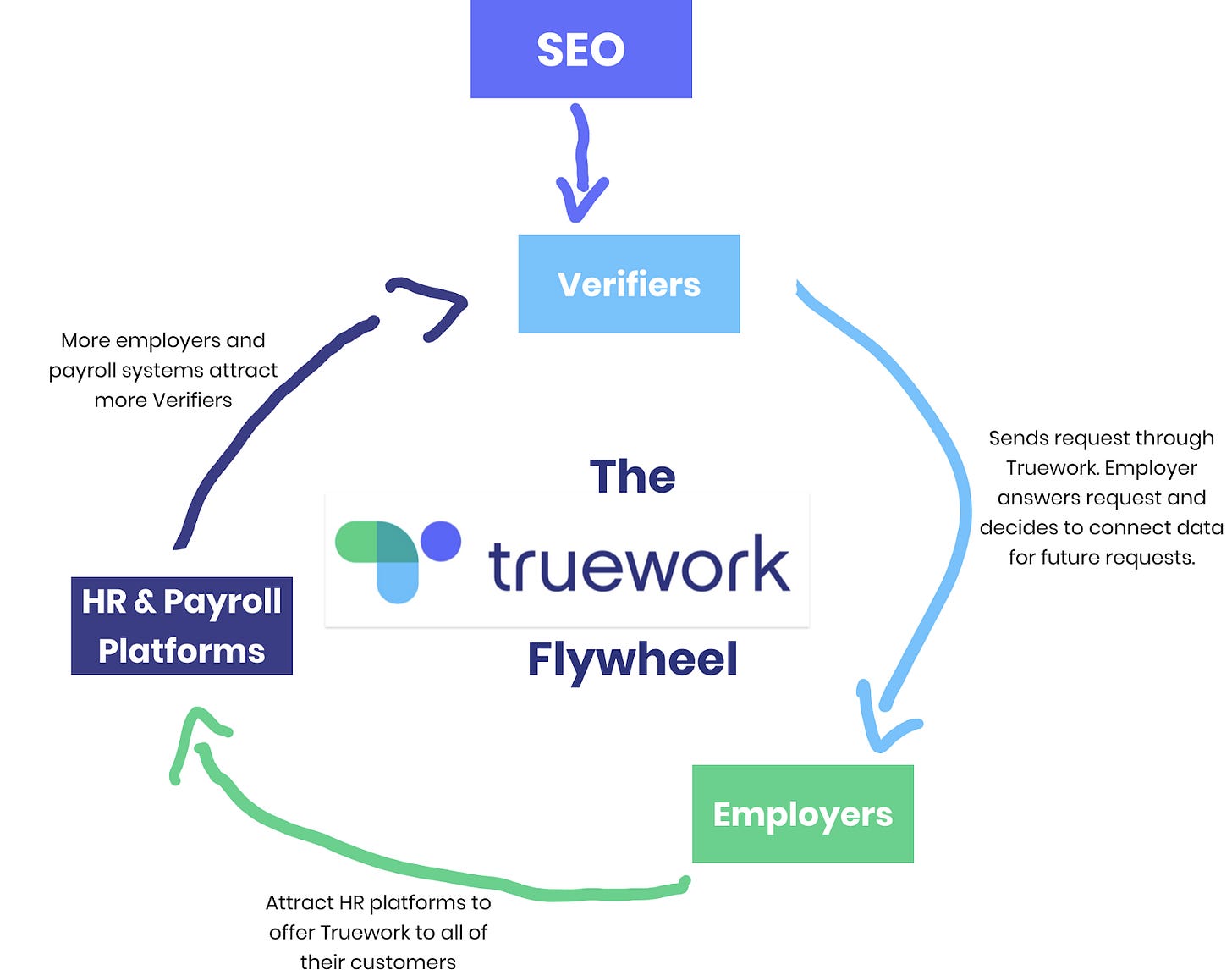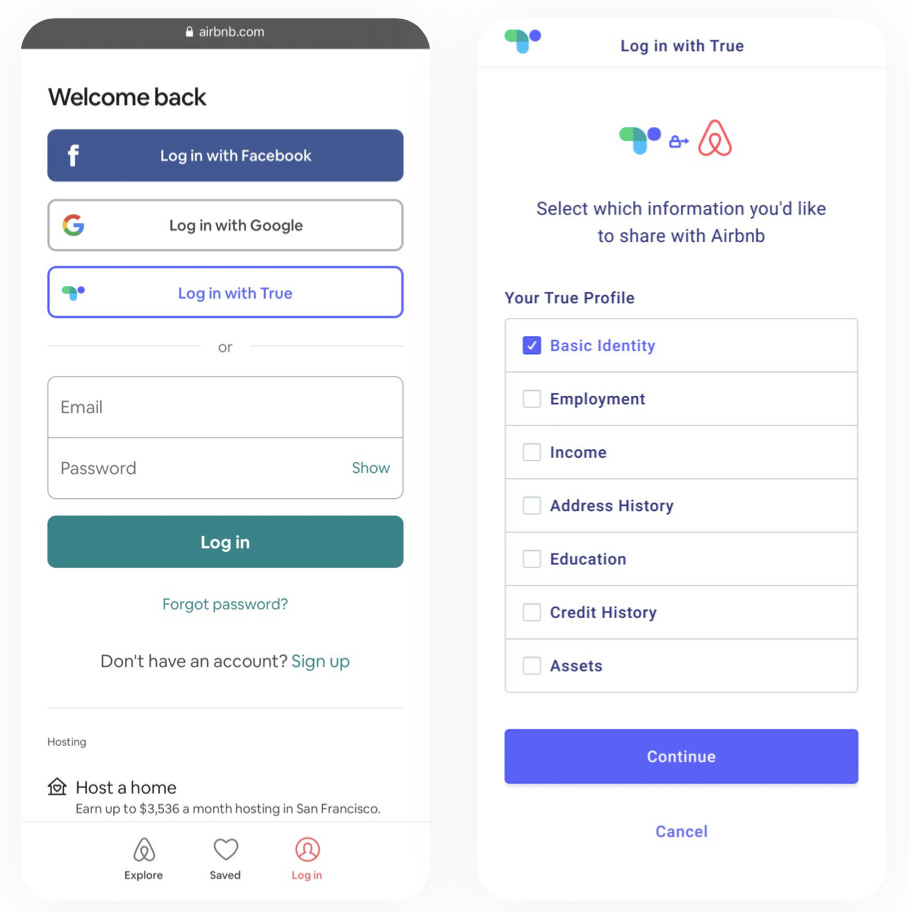Welcome to the 225 newly Not Boring people who have joined us since last Thursday (Substack confirmed they dropped some)! Join 46,444 smart, curious folks by subscribing here:
Today’s Not Boring, the whole thing, is brought to you by … Truework
Read on to learn how Truework is building the verified identity layer of the internet.
Hi friends 👋 ,
Happy Thursday!
I met Ryan Sandler, Truework’s CEO, via an introduction from Ramp co-founder and CTO Karim Atiyeh. Aside from running NYC’s fastest ever unicorn, Karim is also a top angel investor. One mutual friend told me that no one is better at identifying strong engineering teams than Karim. So when he told me I needed to look into Truework, my ears perked up.
Karim was right. Truework reminds me a lot of Ramp, a Not Boring favorite: Rabois-backed, fintech, Harvard founders, going after an absolutely enormous market led by a too-comfortable incumbent, strong technology chops, and a long-term, worldbuilding strategy starting with a smart wedge.
It’s different than Ramp, too. First, it’s not starting with a product that the end-user touches. It built a platform and API used mostly by employers and verifiers. It’s intentionally unsexy. Second, it has a different ambition, which required it to act differently, more quietly, in the beginning. (Until now. That’s why we’re here.) And third, Truework is a privacy-first company.
Truework’s story has lessons for founders, investors, anyone who works in regulated industries, and even incumbents. It’s a masterclass in Worldbuilding.
This essay is a Sponsored Deep Dive on Truework. For those who are new around here, that means that Truework is paying me to write about their business, but that I would have written about it anyway. You can read more about how I pick and work with partners here.
Let’s get to it.
Truework: A True Strategy Masterclass
This is a story about strategy.
It’s also about privacy, identity, income verification, credit bureaus, breaches, regulations, and owning your data. It’s about worldbuilding and unsexiness. It’s about the ability to fill out a mortgage application simply by clicking “login.” But mostly, it’s about strategy.
Truework launched in late 2017 with a vision: empower people to own and control their personal information. That’s one of those “much easier said than done” visions. Others have tried and failed. To succeed, you need a strong wedge, and a master plan.
Truework has both, and is executing on one of the most patient and ambitious worldbuilding strategies I’ve seen, backed by Keith Rabois at Founders Fund, Alfred Lin at Sequoia, and Steve Sarracino at Activant. You don’t assemble that board if you’re fucking around.
Its master plan starts with employment and income verification, a process that touches all of us. If you want a house, a job, or a car, your lender or employer needs to confirm where you work and what you make. It’s a $5+ billion market with one dominant incumbent, a bunch of small players, and a lot of pen, paper, emails, and faxes. It’s broken, unsecure, and slow.
But employment and income verification is a wedge into a much bigger opportunity: to become the verified identity layer for the internet, giving people control of which data they share, and where, and speeding up transactions that require trust.
Truework’s journey thus far, and it’s plan for the next half-decade, is a case study on how tech startups can win huge markets controlled by dominant incumbents without using low-end disruption. Let’s study:
Meet Truework
How to Win a Legacy Industry
Regulatory Counter-Positioning
The Verified Identity Layer
Meet Truework
In 2017, after product managing LinkedIn Salary (a Glassdoor competitor) to launch, Ryan Sandler left LinkedIn and linked up with his Harvard roommate, Ethan Winchell, and fellow LinkedIn-er, engineer Victor Kabdebon, to explore ideas for their own thing.
Having gotten interested in data ethics in college, Sandler knew that he wanted to start a company in the data privacy space, but he didn’t know exactly what the idea was. He did know which boxes it needed to check:
Unsexy
Overlooked by Silicon Valley
Lots of data
Large market
Once they identified spaces that met their criteria, they cold emailed companies to pick their brains, narrowed the list down, and started talking to customers to validate the top ideas. After speaking with mortgage lenders, they chose employment and income verification. Sandler told The Venture Brief they chose the category because of:
How overlooked it was, yet such a big market, and so important in the economy. Every time someone gets a loan, apartment, a new job, there’s sensitive information that needs to be verified about them. Most prominently, their income, employment, assets, credit, other pieces of their identity. And consumers have no idea that this information is being verified and being shared with a ton of third parties.
Employment and income verification checks all the boxes.
Privacy has been a huge issue, despite the sensitivity of the data. ✅
It’s unsexy. ✅
It’s overlooked by Silicon Valley (quick, name your favorite employment and income verification startup). ✅
There’s a ton of data: the product is all about collecting and sharing data, fast and securely. ✅
It’s a massive market. ✅
In 2020, the industry leader did nearly $1.5 billion in revenue, up 51% YoY. Income is one of the best measures for underwriting; verifying that income is the glue that holds lending together. Dodd-Frank, the consumer protection legislation that came out of the housing crash in 2008, even mandates that lenders verify the data before approving a mortgage.
Verification of employment (VOE) and income (VOI) is so critical that even after a data breach that exposed over 145 million Americans’ data, Morningstar analyst Brett Horn told CNN, “I think, frankly, it’s not in the interest of the industry or even regulators to shut down [a credit bureau involved in the leak]. They provide an essential service for consumer lending.”
Until 2017, the industry and regulators didn’t have much of a choice. Enter Truework.
Starting with employment and income verification, Truework is building a digital-first credit bureau that makes it faster for consumers to apply to loans, apartments, jobs, and more, while maintaining privacy.
It’s a three-sided network:
Verifiers: Lenders, landlords, employers, and others need to verify your data in order to give you a loan, rental, or job. They’re the payers in the network, paying each time they need to verify information.
Employers: Employment and income data lives, unsurprisingly, in HR and Payroll systems. Truework works directly with companies, and with payroll providers like Gusto, to access that data directly.
Consumers: The people whose data is being accessed and shared are typically overlooked in this network. They often don’t even know that Employers, Verifiers, and credit bureaus are sharing their information behind the scenes.
Truework brings Consumers into the loop. Employers provide data to Truework, but Truework never shares that data with Verifiers without digital consent each time the data is shared. That seems like it’s obviously the right move, but it’s not the way it works today.
To make the process smooth, fast, and easy for Verifiers, who are the paying customers, Truework has three products that roll up into a one-stop solution for income verification.
The bread and butter is the Instant product. This is what lenders and other Verifiers care about most: with the Consumer’s consent, data is returned cleanly and instantly, without any user friction to cause drop-off. Truework has spent the first 3.5 years of its life building up partnerships with companies and HR and Payroll providers like Gusto, Zenefits, and Paylocity to create a database of 35 million employees. It’s already the second-largest network, and it’s growing quickly (100x in the past year alone).
Truework recently added Credentials to its waterfall. There are a number of players now attacking this part of the waterfall, including Payroll scraping APIs, and Truework partners with them. This is an important piece of the waterfall, but not a full solution by itself and not as preferred as Instant. Payroll scraping APIs have high drop-off rates (think of the number of times you’ve dropped off when asked to provide your banking credentials in Plaid, and multiply that by how hard it is to remember your payroll system password). That’s why it’s just a fallback for Truework, albeit an important one.
For everyone who isn’t covered into those two buckets, Truework has an automated Smart Outreach system backed by a team of employees using proprietary technology to get in contact with HR teams quickly. The difference between the current, fax-heavy process and Truework’s is the difference between dealing with customer service at a bank and at a startup, plus a lot of automation and machine learning to route thousands of requests per day to the right person at hundreds of thousands of HR departments.
The magic of this approach is that Truework is the only one stop solution for Verifiers. They realized early on that until they have all of the data on one network, they needed to become an aggregator, not in the Thompsonian sense, but in the more traditional sense: aggregate access to the data, whether first-party or third-party, via a single, easy-to-use access point in one place. Because of that, Truework is able to verify any applicant, through the waterfall described above: Instant, then Credentials, then Smart Outreach. In order to make sure they have complete coverage, they even work with other credit bureaus and payroll scraper APIs on the backend to fill in gaps.
The one-stop approach is working. Truework now works with over 15,000 SMB lenders using its self-serve product, and the largest mortgage providers in the country now use Truework’s API.
But for Truework to hit its massive vision, it’s going to need to grow its Instant network from 35 million people to over 100 million. To do that, it’s going to need to transform the credit bureau market itself.
How to Win a Legacy Industry
Some startups create new markets. Others come into established markets and compete with entrenched incumbents. Often, they do it via low-end disruption: find an overserved segment of the market, build a pared down, good enough, cheaper product, and then move upmarket.
Truework is competing in a legacy market without low-end disruption, by building a better, consumer-first experience and playing the long game.
To date, the traditional credit bureaus have reigned supreme in identity, including the employment and income verification space. The largest player still covers 80-100 million people compared with Truework’s 35 million. These credit bureaus are so entrenched in verticals like identity that even after multiple massive data breaches, nothing changed.
The major credit bureaus almost seem like quasi-governmental institutions, beyond reproach. (That said, the Biden Administration is contemplating creating a governmental credit reporting agency to compete with, and potentially replace, the existing big three - but it will be an uphill battle.) That’s why no one’s been able to take them head-on, and why Truework’s market checked the “overlooked by Silicon Valley” bucket. It’s why payroll scraper APIs try to go around the credit bureaus instead of competing directly.
But Truework is going head-to-head. This is where this becomes a story about strategy.
Start with the why now. What’s changed?
First, technology. On the Employer side, HR and Payroll platforms recently launched open APIs that make it easy for employers to connect data with Truework. On the Verifier side, more and more lending is going digital, with companies like Roostify, Blend, Better, SoFi, Rocket Mortgage taking a greater share of the market. That created an opening for a tech-first solution like Truework that connects the two sides seamlessly, securely, and instantly. Credit bureaus, on the other hand, are not known for the quality of their APIs.
Second, privacy. Since the Cambridge Analytica scandal, online privacy has become a louder part of the global conversation. Europe passed GDPR and California passed CCPA. Both regulations require consent before sharing employee data. When hackers breached one of the major credit bureaus in 2017, they shone a light on the previously shadowy verification industry, and consumers didn’t love what they saw. It’s a tough time to be a company that shares data without consent.
But privacy is one of those things that people say they care about without opening up their wallets to prove it. The startup graveyard is littered with companies whose main value prop was privacy.
Instead, Truework needed to compete by building a better product with internet-native distribution that also happened to have privacy baked in. It needed to play the long game. It needed to be a Worldbuilder.
In Two Ways to Predict the Future, I wrote that there are two ways that companies go after big markets. “Shotcallers find an obviously big market, guarantee that they’re going to transform it, and try to spend their way into making that happen.” Worldbuilders, on the other hand:
Predict something non-obvious about the way the world is moving before others see it and before the market is ready for their ultimate vision.
Create a wedge into the market and leverage it into a much larger opportunity. The public often ridicules or dismisses the initial wedge product.
They timestamp their vision, whether in public announcements or confidential documents.
Obvious Worldbuilders include Musk and Bezos. This video is classic Worldbuilder:
Predict something non-obvious: Commerce on the internet is going to be massive.
Create a wedge: Books were not the biggest category, but they benefited the most from the internet’s capabilities, and were the right category in which to build the muscle.
Timestamp the vision: Bezos never said books are the end-all-be-all. He said that they were the “first and best product” to sell online.
Truework is a Worldbuilder, too.
Predict something non-obvious: As HR systems and lending move online, there’s an opportunity to build a privacy-first identity layer across the internet.
Create a wedge: Employment and income verification is a vertical of identity that everyone needs that has the least digital competition; it allows Truework to build up its most important asset: data.
Timestamp the vision: The team shared with me a 10-year vision that they set out to accomplish in 2017. They’re executing on it almost perfectly so far, and have big ambitions for the next six years.
Truework found a market with a non-technical incumbent with an approach that was non-obvious to other startups. It had to lay two foundational pieces down before executing on its master plan.
Its first decision, which is common among startups, was to be product-and-engineering first. The incumbent had a distribution advantage -- it worked with most of the large enterprise companies -- so Truework had to win on product. It built a team of top product, engineering, security, and marketing talent from Airbnb, Coinbase, Stripe, Gusto, LinkedIn, Patreon, and Facebook.
From that base, Truework has executed against a master plan to grow its Instant network. Get more Verifiers on the platform to attract more Employers, use more employers to attract more Verifiers, use those Verifiers to attract HR and Payroll Platforms, and so on. It’s Truework’s Flywheel, and its network effect.
It starts with SEO.
SEO
Being technical and internet-native gave Truework the seeds of a distribution edge, as well. Search Engine Optimization (SEO) for employment and income verification was wide open. So, as Sandler told Harry Stebbings, “When you look at how we built our product, it was really with SEO in mind rather than building a product and then trying to send traffic to it, if that makes sense.” When they entered the market, thousands of relevant search terms were wide open.
There are two types of search terms: head terms and tail terms. For employment and income verification, the head term, the thing that most people search for, is “employment verification.” Go search it. It’s littered with ads, and Truework doesn’t even try to compete there. Instead, it focused on the tail terms, which, like it sounds, are the long tail of search terms related to the main topic. In Truework’s case, that’s “[company] employment verification” or “employment verification [company].” Try it. Go search “employment verification [your company].”
Chances are, Truework comes up first. That’s free marketing, and for the first three years, Truework didn’t spend any money on paid acquisition. 95% of submissions came from organic channels. To compete, any incumbent would need to re-architect its system for tail SEO and play catchup to Truework’s 3+ year head-start. It’s too late. This advantage will compound.
Mid-Market
With the early product and SEO infrastructure built, Truework picked a wedge within a wedge to kickstart the market: it decided to go after the HR departments at mid-market companies. Sandler told Stebbings:
People often want to go start at the smallest of SMBs and work their way up. But what a really small, 10 person company, 50 person company, what they want is very different than an enterprise. So, what a mid-market company wants, a company with 500, 2,000 employees, is much more similar to what an enterprise wants. And the sales cycle is much faster. There may be less security requirements. You can actually close these quite large companies in the early days of your company.
Plus, most enterprises already worked with the big incumbent, while most mid-market companies still used manual processes. They had a greater need. As Verifiers needed to verify employees at mid-market companies, they needed to use Truework, bringing demand onto the network.
Verify Any Employee
By 2018, Truework was getting traction in the mid-market. It raised a $2.9 million seed round from Miami CEO Keith Rabois (then a partner at Khosla Ventures). Rabois laid out a framework in 2017 that Truework followed:

While the incumbent dominated the enterprise portion of the market, the overall market was still largely fragmented. There was no one place to go to verify any employee. The incumbent only really verified employees on its network. There were 10-20 smaller, industry-specific players. Truework needed to be the one place where a Verifier could verify any employee, something that’s only feasible for a tech-first company that can easily plug into other systems and automate manual processes.
Still, working with third-parties and automated-but-still-manual processes was lower margin and slower than getting employees on network. Luckily, attracting Verifiers with a one-stop solution let Truework leg up into the next part of its plan.
Embed into HR Platforms
Truework started by selling to mid-market companies. It went door-to-door, signing up one company at a time. 1,000 employees here, 4,500 employees there. It grew quickly enough to raise $12 million from Sequoia’s Alfred Lin (who had a pretty good day on December 9th last year when two of his companies, Airbnb and DoorDash IPO’d on the same day).
It was time for the next step: exclusive distribution through HR and Payroll platforms. HR and Payroll platforms, like ADP, Gusto, Paylocity, Zenefits, Bamboo HR, and more, each work with thousands of Employers and millions of Consumers. They want to work with the employment verification companies that work with the most Verifiers, partly because they get a small cut of every verification transaction, but most importantly, they want to work with consumer-first partners because their own customers are HR professionals tasked with protecting their employees.
As Truework used mid-market sales and SEO to attract more Verifiers, HR and Payroll platforms signed up. In April, Truework announced an exclusive partnership with Gusto, bringing over 100,000 small businesses and their employees into Truework’s network in the click of a Docusign. Gusto chose Truework because the two companies share the belief that employees should control their own data, and because it makes their customers’ -- Employers’ -- lives easier.
With Gusto and other payroll platforms onboard, Truework now has 35 million employees in its network, up from 300 thousand just twelve months ago. Importantly, because partnerships like the one with Gusto are exclusive, Gusto will only work with Truework, and not its competitors.
Verifier API
More Verifiers meant more Employers, either directly or via HR and Payroll Platforms. More Employers meant bigger Verifiers. In 2020, Truework achieved a few big milestones:
SOC2 and ISO20071 Certified. As I wrote about in Secureframe, SOC2 and ISO20071 are a prerequisite for working with enterprise companies.
Launch an API. In March 2020, Truework launched a Verifier API that lets big lenders put Truework verification right in their workflows and to easily handle large volumes of verifications.
Series B Led by Activant. Truework raised a $30 million Series B, led by Activant, a B2B2C-focused venture firm, which fits perfectly with Truework’s B2B2C strategy.
Just a little over three years in, Truework has laddered up from one-off Employers and small, self-serve Verifiers to work with some of the largest lenders and HR platforms in the country.
It has over 35 million employees in-network, ready to be verified instantly, covers all out-of-network employees, and works with 86k users across 15k financial institutions to verify employment and income information. As it grows and unlocks new partnerships, it’s building up a secure database of employee information that puts employees in control, and which it can use to expand into other parts of the verified identity stack.
That’s a hell of a start, the result of a smart strategy executed well. But we haven’t even gotten to the part that I find to be the most fascinating.
The most brilliant and unique weapon in Truework’s arsenal is its use of regulation.
Regulatory Counter-Positioning
Off the top of your head, how many startups can you think of that send regulators letters asking them to strengthen regulation in their industry?
Some crypto startups, like Coinbase, work with regulators because many institutions need more regulatory clarity before investing.
Crowdfunding platforms, like Republic, embrace regulators and work with them to help implement more common sense regulation, of which they are the beneficiaries.
Big incumbents, like Facebook, often pretend that they don’t want to be overly regulated, but as Ben Thompson has pointed out many times, regulation typically favors the big, rich incumbent at the expense of the startup. Zuck is Brer Rabbit: pleading not to be thrown into the regulatory briar patch so that he ends up there.
But for most startups, the dominant model over the past decade has looked something like Uber’s under Travis Kalanick: ask for forgiveness, not permission. Move fast and break things. Startups have huge growth goals and limited resources and regulation can slow them down and waste money.
That’s why it was notable when Truework wrote a letter to the Consumer Financial Protection Bureau asking it to hold Truework and its competitors to higher standards as it makes rules related to Dodd-Frank Section 1033.
Why would they do that? Its biggest competitor has so much more money, and so many more lawyers. You’d think that more regulation would favor the incumbent. It typically does.
In 7 Powers, Hamilton Helmer writes about regulatory capture as one of the ways to achieve the Cornered Resource power. Flo Crivello calls it, “A particularly vicious form of cornered resource,” which is fair, because it’s what happens when a regulatory body is corrupted to serve the interest of the group it’s supposed to be regulating. When regulatory capture occurs, it’s typically the incumbents who benefit, because they have the advantage of the time in market, money, and lobbying power it takes to flip regulators.
But in this case, because Truework’s interests are aligned with the Consumers they built the company to protect, and because Truework is nimble enough to build product to fit any new regulation, regulators can help Truework by helping consumers!
Check out the recommendations Truework is making in its letter to the CPFB:
In case you don’t want to read it, Truework is arguing that consumers should have meaningful control over their data and that trust is a precondition to consumers wanting to exercise that control. The beauty is in the details though.
Truework is recommending common sense things that would clearly be better for consumers, and that are so much easier for a tech company to implement than, say, a large, non-technical incumbent. Aside from the technical stuff, its recommendations fly in the face of the way that credit bureaus work today: use-case specific instead of broad sweeping access, accurate data and the obligation to correct inaccurate data, direct responsibility for API functionality and security.
This isn’t regulatory capture. It’s Regulatory Counter-Positioning. It’s Jiu Jitsu.
It reminds me of the scene in ~half of 80s movies in which the 5th grader bullies the 3rd grader, but then the 3rd grader calls in his much bigger 8th grade brother. Or something like this:
That’s the best part of building a business that’s truly aligned with consumers’ in a space in which that hasn’t always been the case. You can do well by doing good, and tie your competitors in knots in the process.
So where are we? 3.5 years in, Truework has executed on every step of the plan it laid out in 2017, on schedule:
It’s legged up on each side of the three-sided network, and has reached enough scale that regulators now have to take it seriously.
If the CPFB takes its recommendations, it will be in a particularly good position relative to its biggest competitor.
It’s doing all of this while creating an employment and income verification product with a Customer Satisfaction (CSAT) score of 90+.
Plus, it’s sneaking privacy into a product experience that is good enough to stand on its own, and making headway towards letting consumers control their own data.
It’s well on its way towards building the verified identity layer for the internet.
The Verified Identity Layer
The thing you need to understand about great API-first companies is this: they don’t seem very sexy at all, until they do. The best ones are often Worldbuilders. They start with a small, non-obvious wedge, and work their way towards a bold long-term vision.
For Truework, that bold long-term vision is to empower people to own and control their information. As we’ve learned at this point, that’s harder than it sounds. The incumbents make a lot of money owning and controlling that information currently.
Given Truework’s consistent execution against its 2017 10-year plan, though, I wouldn’t bet against them. So what does that master plan look like going forward?
This year, Truework is focused on “broadening the waterfall.” That’s right...
That means more ways to verify from the API to increase the coverage of instant requests. That will bring more big Verifiers onto the system. Meanwhile, it will continue to add new HR and Payroll platform partners and Employers, and continue to improve the consumer experience and gain their trust.
All of this is in service of the larger goal of winning identity, which Truework believes takes three things:
Source of Truth Data: first-party data on 100 million or more Consumers
Large Network of Verifiers: Truework needs to be a trusted source for anyone giving mortgages, loans, or jobs.
Consumer Experience and Trust: While Consumers have thus far played a more passive role, approving when and with whom their data is shared, the next parts of the plan are more Consumer-focused.
Next year, the Consumer is front and center as Truework goes after more of the $100+ billion Identity Verification market. Employment and income verification is important for large, infrequent transactions like mortgages and apartment rentals, but identity verification more broadly, including credit, assets, education, criminal record, driving history, address history, and SSN/DOB, is used in all sorts of places: marketplaces, ecommerce, payments, gig economy onboarding, bank account applications, and more. The average Consumer has their identity verified 300 times per year.
Starting with smaller transactions, like rentals or account creation, anyone verified on Truework will be able to send a Truework profile instead of paperwork or a credit pull.
By 2023, you’ll be able to Login with True on any site that requires verified identity and information, and can choose which information to share with whom. You can create fake Facebook profiles or burner Gmail addresses; your True identity will have all of the verified information, bridging your online and offline identities.
Renting an Airbnb? Prove that you are who you say you are. Applying for a job. Log into Indeed with True. Angel investing? Show your accreditation by logging into AngelList with True. Want to trade crypto? Never take another picture of your ID, and then retake it when it inevitably doesn’t work, ever again.
The possibilities are endless, because many of the experiences that can be built on top of the True API wouldn’t be possible without it. Stripe, Twilio, Plaid, Agora, and the rest of the API-first companies enabled previously impossible or prohibitively expensive use cases. New technology originated lending classes like Buy Now, Pay Later (BNPL). True will make it fast and cheap to verify that you are who you say you are, expanding the possibilities for existing lending classes and making entirely new ones possible.
As Consumers take back ownership of their data, they may even be able to sell it for money or trade it for access or experiences themselves. That’s what Facebook, Google, the credit bureaus, and anyone who “owns” your data today already do. Why not you?
How did you like this week’s Not Boring? Your feedback helps me make this great.
Loved | Great | Good | Meh | Bad
Thanks for reading and see you on Monday,
Packy

























